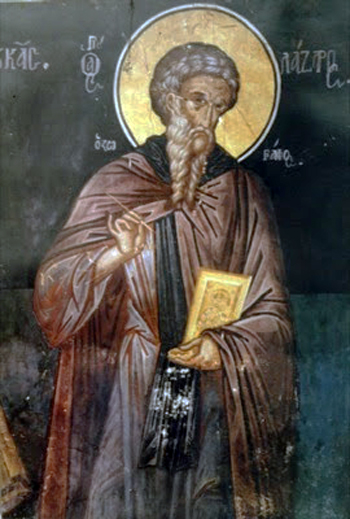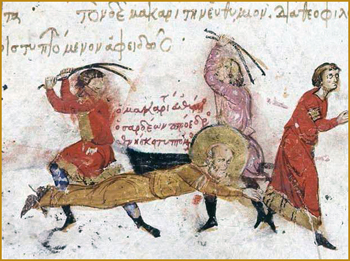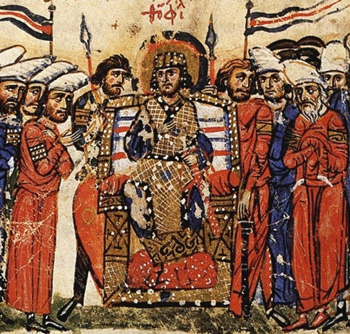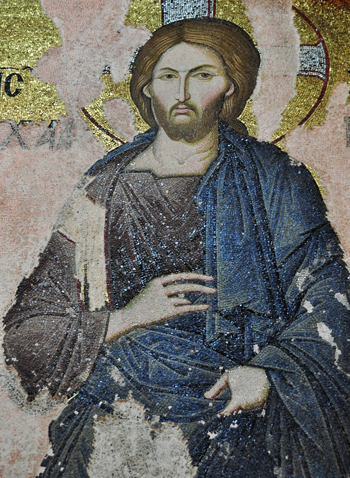The Saint of the Day
 |
 |
 |
 |
 |
 |
 |
St. Lazarus the Iconographer - February 23
Biographical selection:
Lazarus was born in Mount Caucasus and left his parents at an early age to go to Constantinople where he embraced the religious life. Beyond the ordinary exercises of the monastic life, he learned painting, an art cultivated in the cloisters, especially in Constantinople.
 Now then, at his time the war against sacred paintings and statues had been declared by the iconoclasts. The Emperors, not satisfied with breaking the statues and persecuting their defenders, also intimidated the secular painters with rigorous edicts. Thus, the fear of death, imprisonment or exile prevented many artists from making any painting or sculpture of Jesus Christ or the Saints.
Now then, at his time the war against sacred paintings and statues had been declared by the iconoclasts. The Emperors, not satisfied with breaking the statues and persecuting their defenders, also intimidated the secular painters with rigorous edicts. Thus, the fear of death, imprisonment or exile prevented many artists from making any painting or sculpture of Jesus Christ or the Saints.
This situation induced many religious superiors to desire to repair such a loss of religious art. Despite the threats and indignation of the Princes, they introduced the art of sculpture and painting into their monasteries to prevent the holy statues from being totally abolished by the impious.
Lazarus had become very skillful in this profession; the high reputation he acquired was the cause of the keen persecution he had to suffer.
In 829, Emperor Theophilos decreed death to all the painters who refused to destroy the pictures of Saints that they had painted. He ordered Lazarus to leave his monastery and appear before him to carry out the edict in his presence. Since Lazarus did not comply with his command, he resorted to torture.
The torture was so cruel that he thought St. Lazarus would die from the torments. However, he did not. Instead, he recovered his strength and continued to paint.
 The Emperor arrested him again and ordered that he be tortured with burning embers and red-hot iron that scorched him to the bone. He did not die and returned to prison.
The Emperor arrested him again and ordered that he be tortured with burning embers and red-hot iron that scorched him to the bone. He did not die and returned to prison.
Afterwards, Empress Theodora obtained from her husband Lazarus’ liberation and kept him hidden in the Church of St. John the Baptist where he was cured. When he recovered, he painted a picture of the Precursor, which became one of the most famous paintings of his time.
After the death of Theophilos, Empress Theodora and her son Michael III reestablished the cult to images and restored them to their due honor. In gratitude to the Empress, Lazarus repainted the famous Christ the Chalkites over the Chalk Gate of the Imperial Palace in 843.
As he saw the ancient cult fortified, he delivered himself to the holy exercises of the monastic life, desiring to sanctify himself in the obscurity of the cloister, where he died in 867.
Comments of Prof. Plinio:
You see the fidelity of St. Lazarus to his vocation of martyrdom, which led him to face all types of tortures. However, given the great number of martyrs of the Church who were also faithful, I will not insist on this point. Let me focus on a less emphasized point that appears in his life.
 You may see in this description how coherent and perspicacious impiety is in its hatred for the good. How Emperor Theophilos looked for every symptom of the cult to images in order to destroy those who promoted it. We should lament that we, children of light, are not as perspicacious as are the impious.
You may see in this description how coherent and perspicacious impiety is in its hatred for the good. How Emperor Theophilos looked for every symptom of the cult to images in order to destroy those who promoted it. We should lament that we, children of light, are not as perspicacious as are the impious.
Where can we see a similar coherence and perspicacity of the evil ones against the good today?
In present day society there are many people who pretend that the Crusades, the Inquisition and the religious wars sinned against charity because they caused deaths and torture, which, they say, should never be permitted. However, these same people say not a word of censure against the Roman Emperors who martyred Catholics.
You may try to put them against the wall, asking them: “Do you not condemn Diocletian and Nero who made enormous persecutions against Catholics?”
They reply, yawning: “Of course, of course…”
But their dynamic hatred is for those who killed others in the defense of the Faith. Those who killed others combating the Catholic Faith do not raise their dynamic hatred.
They stress the shedding of blood caused by Catholics only as a way to move public opinion in their favor. This attitude shows that this supposed liberal hatred is not against the shedding of blood, but rather against any coherent and vigilant defense of the Catholic Faith. Actually, if they could, these liberals would also persecute those who defend the Faith today.
These same people are cold and unimpressed by the tortures suffered by St. Lazarus; reading the description of his tortures they try to justify the Emperor. However, they are on fire against the Inquisition because it condemned a small number of heretics to death. Thus, we see that they are actually complacent with those who attack the Faith and strongly against those who defend the Faith. The shedding of blood is not what matters to them… Sadly, many people has this mindset.
If you want to make a test in the milieus you frequent, you can do this: Speak well of the Inquisition and some persons will rise up against the Inquisition. Then, speak about the tortures inflicted on St. Lazarus by the iconoclastic Roman Emperor Theophilos. It is likely the reaction will be cold opposition, a mere platonic hatred of the persecutor. This platonic hatred actually is not hatred.
 What this means is that, in some part of their souls, these persons are complacent with the idea of killing Catholics who defend the integrity of the Catholic Faith.
What this means is that, in some part of their souls, these persons are complacent with the idea of killing Catholics who defend the integrity of the Catholic Faith.
If we are unable to see the evil that the liberal harbors in his soul, we should ask St. Lazarus for the grace to discern in those impious ones their hatred for the good position and, deep down, for us, personally.
Someone could say: “But what is the advantage of this test? l get along well with these persons of the world… They are wealthy and influential men who converse amiably. Now, you come with your tests and analyses and make me believe that there is a Nero or a Caligula inside of these men who treat me well in the world. You are spoiling the joy I have in dealing with them. And this seems to give you satisfaction.”
Here is my answer: A person who does not hate evil does not know and love the good. The knowledge of the evil is indispensable in order to know the good by contrast. After original sin, we are obliged to acknowledge the evil that surrounds us. It is necessary to measure the evil in its full dimensions in order to know and love the good in all its nobility.
Then, we need to make a concrete exercise to discern the degree of evil that our acquaintances have. If we do not do this, we may also admit some bit of complacency with the Revolution in our souls.
So, this is what I have to present for your consideration, inspired by the life of St. Lazarus, the iconographer and sculptor of statues. May he help us to acquire the plenitude of the counter-revolutionary spirit.


The Saint of the Day features highlights from the lives of saints based on comments made by the late Prof. Plinio Corrêa de Oliveira. Following the example of St. John Bosco who used to make similar talks for the boys of his College, each evening it was Prof. Plinio’s custom to make a short commentary on the lives of the next day’s saint in a meeting for youth in order to encourage them in the practice of virtue and love for the Catholic Church. TIA thought that its readers could profit from these valuable commentaries.
The texts of both the biographical data and the comments come from personal notes taken by Atila S. Guimarães from 1964 to 1995. Given the fact that the source is a personal notebook, it is possible that at times the biographic notes transcribed here will not rigorously follow the original text read by Prof. Plinio. The commentaries have also been adapted and translated for TIA’s site.
Lazarus was born in Mount Caucasus and left his parents at an early age to go to Constantinople where he embraced the religious life. Beyond the ordinary exercises of the monastic life, he learned painting, an art cultivated in the cloisters, especially in Constantinople.

St Lazarus the Iconographer (810-865)
This situation induced many religious superiors to desire to repair such a loss of religious art. Despite the threats and indignation of the Princes, they introduced the art of sculpture and painting into their monasteries to prevent the holy statues from being totally abolished by the impious.
Lazarus had become very skillful in this profession; the high reputation he acquired was the cause of the keen persecution he had to suffer.
In 829, Emperor Theophilos decreed death to all the painters who refused to destroy the pictures of Saints that they had painted. He ordered Lazarus to leave his monastery and appear before him to carry out the edict in his presence. Since Lazarus did not comply with his command, he resorted to torture.
The torture was so cruel that he thought St. Lazarus would die from the torments. However, he did not. Instead, he recovered his strength and continued to paint.

St. Lazarus cruelly tortured
Afterwards, Empress Theodora obtained from her husband Lazarus’ liberation and kept him hidden in the Church of St. John the Baptist where he was cured. When he recovered, he painted a picture of the Precursor, which became one of the most famous paintings of his time.
After the death of Theophilos, Empress Theodora and her son Michael III reestablished the cult to images and restored them to their due honor. In gratitude to the Empress, Lazarus repainted the famous Christ the Chalkites over the Chalk Gate of the Imperial Palace in 843.
As he saw the ancient cult fortified, he delivered himself to the holy exercises of the monastic life, desiring to sanctify himself in the obscurity of the cloister, where he died in 867.
Comments of Prof. Plinio:
You see the fidelity of St. Lazarus to his vocation of martyrdom, which led him to face all types of tortures. However, given the great number of martyrs of the Church who were also faithful, I will not insist on this point. Let me focus on a less emphasized point that appears in his life.

Emperor Theophilos promoted the iconoclast heresy
Where can we see a similar coherence and perspicacity of the evil ones against the good today?
In present day society there are many people who pretend that the Crusades, the Inquisition and the religious wars sinned against charity because they caused deaths and torture, which, they say, should never be permitted. However, these same people say not a word of censure against the Roman Emperors who martyred Catholics.
You may try to put them against the wall, asking them: “Do you not condemn Diocletian and Nero who made enormous persecutions against Catholics?”
They reply, yawning: “Of course, of course…”
But their dynamic hatred is for those who killed others in the defense of the Faith. Those who killed others combating the Catholic Faith do not raise their dynamic hatred.
They stress the shedding of blood caused by Catholics only as a way to move public opinion in their favor. This attitude shows that this supposed liberal hatred is not against the shedding of blood, but rather against any coherent and vigilant defense of the Catholic Faith. Actually, if they could, these liberals would also persecute those who defend the Faith today.
These same people are cold and unimpressed by the tortures suffered by St. Lazarus; reading the description of his tortures they try to justify the Emperor. However, they are on fire against the Inquisition because it condemned a small number of heretics to death. Thus, we see that they are actually complacent with those who attack the Faith and strongly against those who defend the Faith. The shedding of blood is not what matters to them… Sadly, many people has this mindset.
If you want to make a test in the milieus you frequent, you can do this: Speak well of the Inquisition and some persons will rise up against the Inquisition. Then, speak about the tortures inflicted on St. Lazarus by the iconoclastic Roman Emperor Theophilos. It is likely the reaction will be cold opposition, a mere platonic hatred of the persecutor. This platonic hatred actually is not hatred.

Christ the Chalkites
If we are unable to see the evil that the liberal harbors in his soul, we should ask St. Lazarus for the grace to discern in those impious ones their hatred for the good position and, deep down, for us, personally.
Someone could say: “But what is the advantage of this test? l get along well with these persons of the world… They are wealthy and influential men who converse amiably. Now, you come with your tests and analyses and make me believe that there is a Nero or a Caligula inside of these men who treat me well in the world. You are spoiling the joy I have in dealing with them. And this seems to give you satisfaction.”
Here is my answer: A person who does not hate evil does not know and love the good. The knowledge of the evil is indispensable in order to know the good by contrast. After original sin, we are obliged to acknowledge the evil that surrounds us. It is necessary to measure the evil in its full dimensions in order to know and love the good in all its nobility.
Then, we need to make a concrete exercise to discern the degree of evil that our acquaintances have. If we do not do this, we may also admit some bit of complacency with the Revolution in our souls.
So, this is what I have to present for your consideration, inspired by the life of St. Lazarus, the iconographer and sculptor of statues. May he help us to acquire the plenitude of the counter-revolutionary spirit.

 | |
|
|
The texts of both the biographical data and the comments come from personal notes taken by Atila S. Guimarães from 1964 to 1995. Given the fact that the source is a personal notebook, it is possible that at times the biographic notes transcribed here will not rigorously follow the original text read by Prof. Plinio. The commentaries have also been adapted and translated for TIA’s site.


